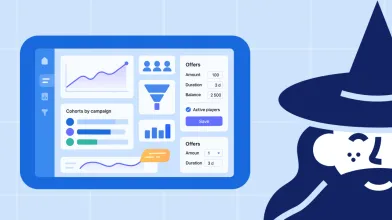What are the key challenges in the gaming market, and how can Magify help solve them?
March 5, 2025
The mobile gaming market is facing tough times. Starting in 2022 and continuing in 2024, we’ve seen a market correction following two years of rapid growth driven by the lockdowns. However, mobile gaming remains the most successful and profitable sector, with global games revenue projected to grow to $205 billion by 2026.
As competition intensifies, user expectations continue to rise. Developers must adopt new approaches to create profitable games in this ever-evolving landscape. Below, we’ll explore the key challenges gaming studios face and actionable solutions to overcome them.
Challenges:
1. Rising cost of traffic
The cost per install (CPI) continues to increase, making initial investments in game promotion significantly more expensive. While stabilization has been observed in hyper-casual and simulation genres due to optimized advertising strategies, other categories, such as mid-core and strategy games, still experience rising CPIs. This is especially true in high-competition regions like the United States and Western Europe, where markets are saturated.
- Boosting lifetime value (LTV): Utilize advanced analytics like Magify to identify high-value players and improve retention through personalized LiveOps campaigns.
- Optimizing user acquisition (UA): Leverage predictive ROAS models to allocate budgets more effectively and run A/B tests on ad creatives and targeting strategies.
- Expanding organic reach: Improve App Store Optimization (ASO) to attract players without relying heavily on paid campaigns. Optimized titles, descriptions, and creatives reduce acquisition costs.
- Collaborative marketing: Partner with influencers and content creators to drive organic traffic, especially in emerging markets with lower CPIs.
- Dynamic campaign management: Use tools like Magify to analyze real-time UA performance and adjust strategies to prioritize high-ROI channels and creatives.
2. High cost of development until breakeven
Creating a high-quality game that reaches profitability requires substantial investments in both development and marketing. With rising competition and increasing CPI, studios face mounting pressure to ensure their projects can generate sufficient revenue to break even.
Numbers talk:
- Development costs for casual games range from $500,000 to $1,500,000 while mid-core games often exceed $2,000,000.
- Time to breakeven for casual games typically ranges from 6 to 12 months, while mid-core games often take 12 to 24 months or more to recover initial investments.
Solutions:
Forecasting profitability:
- Leverage predictive analytics tools like Magify to estimate LTV, ROAS, and retention metrics before committing significant resources.
- Run early market viability tests to validate the game’s potential profitability.
Reducing development costs
- Use SaaS tools like Magify for analytics and LiveOps to eliminate the need for costly custom-built solutions.
- Implement remote configurations to make adjustments dynamically, saving time and reducing expenses tied to app updates.
Optimizing early testing and soft launches
- Conduct A/B testing on monetization strategies, ad placements, and in-game mechanics to optimize revenue potential.
- Use real-time data to identify and prioritize key areas for improvement during soft launches.
Building for long-term success
- Plan and execute LiveOps campaigns post-launch to extend player retention and maximize ROI.
3. Difficulty in making product decisions without a data-driven approach
The mobile gaming market remains dominant, generating billions in annual revenue. However, success is increasingly difficult for studios, especially those without access to advanced analytics. According to recent reports, 83% of mobile games fail to achieve sustainable success within three years of launch.
Solutions:
- Establishing Threshold Metrics Across Development Stages:
- Define KPIs such as retention benchmarks (Day 1 > 40% for casual games, Day 7 > 15%) and early ARPU ($0.05–$0.15 during soft launch).
- Use these metrics to identify non-viable projects and reallocate resources.
- Leveraging Data-Driven Tools: Platforms like Magify consolidate analytics to provide actionable insights across marketing tests, soft launches, and live player behavior.
- Regular A/B Testing and Market Validation: Test game mechanics, monetization strategies, and ad creatives to optimize performance.
- Player Sentiment Analysis: Combine quantitative data with qualitative feedback from reviews and forums to get a complete picture of player satisfaction.
4. Competitive Advantage of BI Systems Among Major Players
Mid-sized and large studios gain a significant edge through advanced BI systems, leveraging data for superior analytics and process optimization. For smaller studios, the lack of such tools can create a substantial barrier to growth. By adopting SaaS BI and LiveOps tools, smaller studios can level the playing field, making data-driven decisions that increase profitability and accelerate growth.
Solutions
- Utilize SaaS BI Platforms
- SaaS tools like Magify offer smaller studios access to advanced analytics and predictive models without the high costs of custom-built BI systems.
- Leverage LiveOps for Player Engagement
- Magify’s LiveOps tools enable dynamic updates, personalized offers, and A/B testing, helping small studios optimize ARPPU and retention in real-time.
- Focus on Cost-Efficiency
- SaaS solutions reduce overhead while providing the flexibility and scalability needed to compete with larger studios.
5. The Challenge of Maximizing LTV (Lifetime Value)
Maximizing a game’s LTV is crucial for profitability, as it ensures higher returns on acquisition costs and supports long-term success.
Solutions:
- Optimize Game Balance and Monetization: Use analytics to fine-tune difficulty curves and in-game economies, ensuring players stay engaged and maximize spending potential.
- Leverage Segmentation and Personalization: Magify’s segmentation tools allow studios to deliver tailored offers, in-game content, and monetization strategies to specific player groups.
- Implement Dynamic LiveOps: Real-time updates, targeted events, and personalized offers keep players engaged and boost retention.
- Lifecycle-Based Personalization: Adapt offers and experiences as players progress, from welcoming new players to incentivizing advanced users with premium content.
What Magify gives you for sustainable growth?
1. Advanced Analytics for UA, Monetization, and Product Insights
- All-in-One Analytics: Track and analyze metrics across user acquisition, monetization, product performance, and game balance in one platform.
- Comprehensive Views: Gain insights from multiple perspectives, ensuring teams can make informed decisions beyond their specific domain.
- Intuitive Dashboards: Pre-configured dashboards simplify tracking key metrics without requiring complex setups.
2. LiveOps and Personalization
- Dynamic Player Segmentation: Group players by behavior, progress, or spending patterns to deliver tailored experiences.
- Personalized In-Game Offers: Use Magify's segmentation and offer builder to create custom offers that boost engagement and LTV.
- Real-Time Updates: Adapt game parameters, events, and promotions dynamically without app updates.
3. Accessibility for Studios of Any Size
- No In-House BI Needed: Eliminate the need for a dedicated BI and offer management team, saving time and operational costs.
- Scalable Solutions: Whether you're a small team or a mid-sized studio, Magify makes data actionable and easy to use.
4. Seamless Integrations
- Pre-Built Connections: Magify integrates with all major MMPs, ad networks, and traffic sources for streamlined data flow.
- Two-Stage SDK Setup:
- Basic Integration: Requires just a few days of development effort to enable full user-level analytics quickly and effectively.
- Advanced Integration: Unlocks powerful LiveOps functionalities, including segmentation, dynamic updates, and personalized offers.
- Comprehensive Support: Our team of experienced developers provides hands-on assistance during SDK setup, ensuring smooth implementation and maximum efficiency for your product.
5. Experimentation and Fraud Prevention
- A/B Testing: Test and validate product and monetization hypotheses with built-in A/B testing functionality.
- Purchase Validation: Prevent fraud and ensure accurate data with Magify’s in-app purchase and subscription validation system.
In a world where data plays a crucial role, Magify becomes your reliable partner on the path to creating successful games. Try our solutions today and take a step forward in the mobile gaming market!



